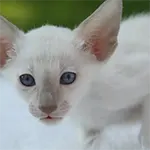Origin and History
The Javanese cat is part of the Oriental family of breeds, closely related to the Siamese, Balinese, and Oriental Shorthair. Its development in the United States during the 1950s and 1960s aimed to create a cat similar in type to the Siamese but with a longer coat and in a wider range of colors. The breed’s name, “Javanese,” does not indicate an origin from Java (Indonesia) but was chosen to continue the naming convention of using Southeast Asian place names for Oriental cat breeds. The Javanese was initially recognized as a separate breed due to its distinctive long coat and color points outside the traditional Siamese color range. However, in many cat associations today, the Javanese is merged with the Balinese breed or considered a part of the Oriental breed group, emphasizing its close relationship to these other breeds.
Appearance
The Javanese sports an elegant, svelte, and muscular body typical of the Oriental breeds, with long slender legs, a whippy tail, and large ears that contribute to its distinctive appearance. The breed’s most notable feature is its medium-length, silky coat, which lies close to the body and has a fine texture, without the undercoat typical of many long-haired breeds. This results in fewer tangles and mats, making the coat relatively easy to care for.
Javanese cats are known for their striking color points, which can include a wide range of colors such as red, cream, lynx (tabby) points, and tortie points, in addition to the traditional seal, blue, chocolate, and lilac points. Their almond-shaped eyes are typically a vivid blue, a trait inherited from their Siamese ancestry.
Personality and Temperament
Javanese cats share the vocal, people-oriented, and affectionate personality of the Siamese. They are highly social, enjoying the company of their human families and often following them around the house to be involved in whatever activities are taking place. Javanese are known for their intelligence and can be taught tricks and enjoy interactive play with toys.
Their vocal nature means they are not shy about expressing their needs and desires, whether it’s for food, attention, or playtime. Despite their talkative tendencies, they have a softer and more melodious voice compared to the Siamese.
Health
Overall, the Javanese is a healthy breed, but it may be prone to some genetic health issues common among Oriental and Siamese cats. These can include dental problems, heart issues such as hypertrophic cardiomyopathy, and respiratory conditions like asthma. A well-cared-for Javanese cat, with regular veterinary check-ups and a healthy lifestyle, can expect to live into its mid to late teens.
The breed’s long coat does not require as much grooming as other long-haired breeds, but regular brushing is recommended to remove loose hair and prevent hairballs. Their social and active nature makes them well-suited to environments where they will receive plenty of attention and stimulation.
In summary, the Javanese cat is a beautiful, intelligent, and affectionate breed that thrives on human companionship. Its elegant appearance, combined with its playful and loving nature, makes it a delightful addition to many homes.










